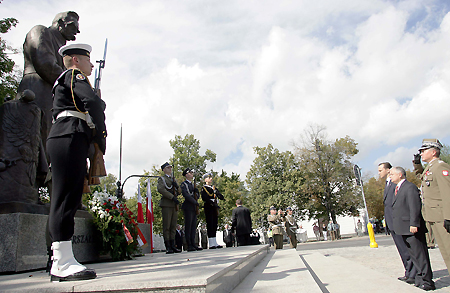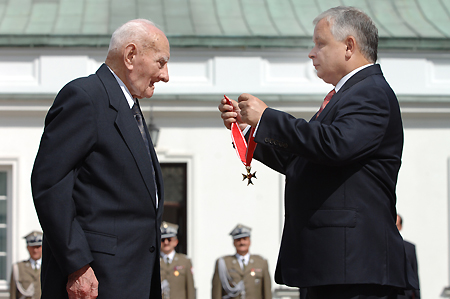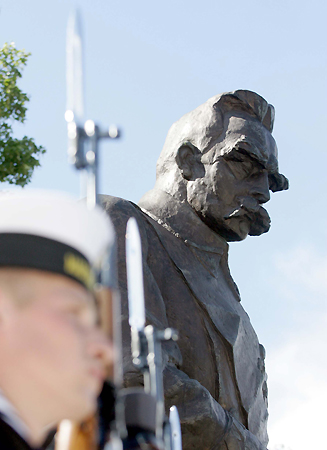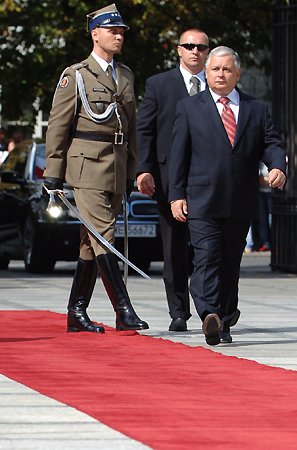





























Posted on 08/15/2006 12:22:29 PM PDT by lizol
Anniversary of the 1920 Battle of Warsaw marked as Polish Army Day
15.08.2006
Today is Polish Army Day.
It is observed on the anniversary of the victorious battle of 1920 against the Soviet army fought on the outskirts of Warsaw.
President Lech Kaczynski laid wreaths at the monument to Marshal Jozef Pilsudski, the architect of that victory, and at the Tomb of the Unknown Soldier, where a ceremonial changing of the guard was held.
A memorial to Polish soldiers who died in the peace and stabilizations missions has been unveiled in Warsaw. Since 1953 Polish troops have taken part in 66 missions around the world, including Iraq, Afghanistan, Lebanon and the Balkans. Sixty eight of them died. At present, 2,500 Polish soldiers serve in peace missions abroad.
The Battle of Warsaw, often referred to as the Miracle on the Vistula, saved Poland’s independence. It is described by historians as one of the most dazzling operations in European military history. One of the last surviving heroes of the 1920 War, 101-year old Zenon Jankowski has been decorated with the Gold Medal for services in the defense of Poland.






























Long live Free Poland!
Ping
Marshal Pilsudski is one of the unsung heroes of the 20th century. His victory in 1920 was the result of great courage and determination at a time when Polish defeat seemed certain.
Katyn Forest monument.
Trying to do my best :-)
Ditto.
Another great Pole -
General Pulaski Memorial Day, 2004 by the President of the United States of America a Proclamation
The story of Revolutionary War hero Brigadier General Casimir Pulaski is one of bravery and sacrifice that helped to secure America's blessings of liberty. We remember General Pulaski for his skill in battle, his commitment to freedom, and his willingness to give his life for America's independence.
Born in Poland in 1745, Casimir Pulaski first gained distinction as a military hero while fighting to defend his native Poland. His reputation as a bold warrior and his dedication to the cause of liberty became known throughout Europe.
Pulaski met with Benjamin Franklin in Paris in 1777 and agreed to join the Americans in their fight for freedom. He quickly proved to be a gifted military leader and was commissioned as a Brigadier General. He became known as "the Father of the American Cavalry," recruiting and training a special corps of American, Polish, Irish, French, and German troops who fought with great skill and success. During the siege of Savannah in 1779, General Pulaski was mortally wounded, leaving a legacy of heroism that continues to inspire people around the world.
On General Pulaski Memorial Day, we honor a noble patriot committed to the cause of freedom, and we recognize the countless contributions Polish Americans have made to our Nation and our culture. We also celebrate the strong friendship between the United States and Poland, remembering our shared history and common values and honoring the sacrifices of Polish troops who have served bravely alongside American and coalition forces in Iraq and Afghanistan.
NOW, THEREFORE, I, GEORGE W. BUSH, President of the United States of America, by virtue of the authority vested in me by the Constitution and laws of the United States, do hereby proclaim October 11, 2004, as General Pulaski Memorial Day. I encourage all Americans to commemorate this occasion with appropriate programs and activities paying tribute to Casimir Pulaski and honoring all those who defend freedom.
IN WITNESS WHEREOF, I have hereunto set my hand this eleventh day of October, in the year of our Lord two thousand four, and of the Independence of the United States of America the two hundred and twenty-ninth.
GEORGE W. BUSH



And don't forget this. Aug 18-21 2006 will mark the 62nd Anniversary of the Polish 1st Armored Divisions battle to close the Falaise Gap, This battle is the accepted end point of the Normandy Campaign in World War 2 that started with the June 6th D Day invasion.
http://www.bbc.co.uk/ww2peopleswar/stories/46/a2879346.shtml
The Canadians; diarist recorded that the scene they encountered when they relieved the Polish divisions was the most savage the regiment had ever encountered. The Poles had received no supplies for three days; they had several hundred wounded whom they had been unable to evacuate and they held some eight hundred prisoners. The road was jammed with burnt out vehicles, theirs and the enemys. There were corpses everywhere, unburied and dismembered. Amid these horrors, the Polish Commander received the Canadians shaking with emotion. His soldiers told long stories to the Canadians, who did not understand a word but roared with laughter all the same. During the next days, the bodies of 325 Polish soldiers killed in the battle of the Falaise Gap would be found makeshift graves near the positions where they had fallen. On the summit of The Mace, sappers of the Royal Canadian Engineers, in tribute to their comrades-in-arms, erected a makeshift signboard. It bore, in English, the simple inscription: "A Polish Battlefield"
Something about Pulaski, American Pilots and Battle of Warsaw:
"On October 9, 1779, probing for a weak point in the British lines at Savannah, Georgia, Casimir Pulaski was mortally wounded by grapeshot. He was carried from the field of battle by several comrades, including Colonel John C. Cooper. Following the American Revolution, Colonel Cooper gave an intergenerational mandate to his descendants that they try and repay the debt of honor owed to Pulaski and his fellow Polish volunteers who fought “for your freedom and for ours” in the War of American Independence. In response to this mandate, Cooper’s great-great-grandson, Merian C. Cooper, organized in August of 1919 the Kosciuszko Squadron, the beginning of the Polish Air Force, with eight American aviators. In the Polish-Soviet War of 1920, Cooper’s men used their tiny air force successfully to break up attacks by the Konarmiya of General Semyon Budyonnyi (whose chief political commissar was Joseph Stalin). It was this use of air power which prevented the linkup of the armies of Tukachevsky and Budyonnyi and thus made possible the “Miracle on the Vistula” battle which started on August 15, 1920. The Konarmiya was the last example in warfare of a cavalry unit of corps/army size."
Disclaimer: Opinions posted on Free Republic are those of the individual posters and do not necessarily represent the opinion of Free Republic or its management. All materials posted herein are protected by copyright law and the exemption for fair use of copyrighted works.